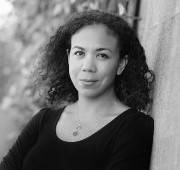2018 School Spending Survey Report
Stephanie Kuehn on the Unreliable Narrator, Mental Health, and "The Smaller Evil"
The YALSA/Morris Award winner and SLJTeen Live speaker continues to spin unnerving tales; SLJ chats with her about her latest YA.
 As with most stories, there were many pieces of the real world that inspired this book: a strange trip to the Esalen Institute when I was a young teen, friends in my early adulthood who dabbled with similar self-actualization groups, my enduring love for both Santa Cruz, CA, and Big Sur, my fear of heights, and my passion for narratives where nothing is ever as it seems, like in John Fowles’s The Magus. The greatest inspiration, however, was my desire to explore our culture’s dependence on independence. From birth, practically, we’re told that we should be able to self-soothe, to sleep alone and cry it out. We’re supposed to find our truest selves and then be unfailingly true to those selves—self-actualized—as if who we are isn’t meant to be influenced by those around us, as if we aren’t all products of our environments. On the flip side, we devalue dependence, having needs, and needing others. In doing so, we’ve set up this strange paradox where we’re dependent on other people to validate our sense of independence. Your books often center on an unreliable male narrator with mental health issues. What is it about that type of protagonist that influences you to write about it again and again? My background is in psychology, and some of my earliest clinical training (which was when I started writing) involved working in a range of settings with children and adolescents, primarily boys. As a woman who grew up with two sisters, I had to consciously deconstruct my own worldview around gender (as well as race and class and age and more) to try to understand a myriad of very different socially constructed ideas, values, and attitudes, as well as the context and systems that support it all. When I write, I’m asking questions, not answering them, and I enjoy exploring a gender and identity that is different from mine. It helps me understand my world and feel connected to the work I do. With regard to mental health, it’s the lens I view everything through. I’m drawn to stories about people who are disconnected from their emotions in some way. Where their fear is expressed as anger. Or anger becomes self-loathing. Or desire becomes shame. Maybe that’s the unreliability of all these characters: this mismatching of their emotions and the consequences stemming from it. In therapy, people can learn to correctly identify their emotions and how to regulate them in healthy ways. However, the boys (and girls) I write about may or may not be learning these things. They may or may not be able to. What kind of research did you do on the kind of retreat center that Arman and the other characters attend? I was already pretty familiar with these types of groups when I started writing the story. Growing up in the Bay Area in the Seventies and Eighties, I was familiar with movements like Est [Erhard Seminars Training]. I’d also done previous research on cults and the ways in which groups can foster dependence by isolating vulnerable people. However, I also interviewed people who had participated in some [cultish] retreats and had really positive, empowering experiences. Every time I read one of your books, no matter how often I tell myself, “There must be a twist coming,” I can never anticipate exactly what twist it might be. How do you plot your novels? Do you always know the outcome once you start writing? I never know how the story will end, but I do know who the characters are, and I have some idea of what the outcome (emotionally speaking) will be for them. I also try not to think about plot twists as anything other than the natural progression of the plot. So in Charm & Strange and Complicit, those books were told in first person by characters with secrets they were hiding from themselves. With Delicate Monsters, I wrote that book in third person in order to pull back from the intimacy of the first-person narrator. I actually tried to plot that story in relation to a David Fincher film. If my first two books were Fincher’s take on Fight Club—internal stories with a twist—I wanted this one to be more Seven, which doesn’t rely on a twist but instead on the inevitable collision of characters set out from the start to hurtle toward tragedy. There are intermittent chapters written by a mysterious first-person narrator whose identity readers won’t be sure of until the last page. Was that voice always part of the narrative? Those chapters were not there from the start. I really had to plumb deep for what I was trying to say with the story before I found that second voice. Because there’s the primary story line of Arman running away to become what he perceives to be a better person while also seeking a place of belonging. But that’s not all I was trying to get at. So the second narrative is meant to probe at: What if you do find where you belong but it just happens to not be a very good place? Which character do you identify with most? Which was the most difficult to write? While I would never make the choices he does, the character I identify with most is Beau, the leader of the self-actualization group. As an adult, and in the field that I’m in and also in writing for teens, [I find that] there’s a lot to think about in terms of power dynamics, ethics, empowerment, and manipulation. I’m always thinking about these things. The most difficult character to write was the cook, because you’re only able to see her from Arman’s perspective and his experience of her. But she has what he’s looking for: both positive self-regard and a place of belonging in a system she finds meaningful. What are you working on now? I’m working on a new young adult novel. I’m sure it’s similar in some ways to my other books, but it also feels different. It’s not a mystery. The narrator isn’t particularly unreliable. The structure is linear and straightforward. It’s about love and loathing, spite and beneficence, and more than anything, it is a confession. It’s also the longest thing I’ve ever written, although that’s not saying much, since my books tend to be quite short.
As with most stories, there were many pieces of the real world that inspired this book: a strange trip to the Esalen Institute when I was a young teen, friends in my early adulthood who dabbled with similar self-actualization groups, my enduring love for both Santa Cruz, CA, and Big Sur, my fear of heights, and my passion for narratives where nothing is ever as it seems, like in John Fowles’s The Magus. The greatest inspiration, however, was my desire to explore our culture’s dependence on independence. From birth, practically, we’re told that we should be able to self-soothe, to sleep alone and cry it out. We’re supposed to find our truest selves and then be unfailingly true to those selves—self-actualized—as if who we are isn’t meant to be influenced by those around us, as if we aren’t all products of our environments. On the flip side, we devalue dependence, having needs, and needing others. In doing so, we’ve set up this strange paradox where we’re dependent on other people to validate our sense of independence. Your books often center on an unreliable male narrator with mental health issues. What is it about that type of protagonist that influences you to write about it again and again? My background is in psychology, and some of my earliest clinical training (which was when I started writing) involved working in a range of settings with children and adolescents, primarily boys. As a woman who grew up with two sisters, I had to consciously deconstruct my own worldview around gender (as well as race and class and age and more) to try to understand a myriad of very different socially constructed ideas, values, and attitudes, as well as the context and systems that support it all. When I write, I’m asking questions, not answering them, and I enjoy exploring a gender and identity that is different from mine. It helps me understand my world and feel connected to the work I do. With regard to mental health, it’s the lens I view everything through. I’m drawn to stories about people who are disconnected from their emotions in some way. Where their fear is expressed as anger. Or anger becomes self-loathing. Or desire becomes shame. Maybe that’s the unreliability of all these characters: this mismatching of their emotions and the consequences stemming from it. In therapy, people can learn to correctly identify their emotions and how to regulate them in healthy ways. However, the boys (and girls) I write about may or may not be learning these things. They may or may not be able to. What kind of research did you do on the kind of retreat center that Arman and the other characters attend? I was already pretty familiar with these types of groups when I started writing the story. Growing up in the Bay Area in the Seventies and Eighties, I was familiar with movements like Est [Erhard Seminars Training]. I’d also done previous research on cults and the ways in which groups can foster dependence by isolating vulnerable people. However, I also interviewed people who had participated in some [cultish] retreats and had really positive, empowering experiences. Every time I read one of your books, no matter how often I tell myself, “There must be a twist coming,” I can never anticipate exactly what twist it might be. How do you plot your novels? Do you always know the outcome once you start writing? I never know how the story will end, but I do know who the characters are, and I have some idea of what the outcome (emotionally speaking) will be for them. I also try not to think about plot twists as anything other than the natural progression of the plot. So in Charm & Strange and Complicit, those books were told in first person by characters with secrets they were hiding from themselves. With Delicate Monsters, I wrote that book in third person in order to pull back from the intimacy of the first-person narrator. I actually tried to plot that story in relation to a David Fincher film. If my first two books were Fincher’s take on Fight Club—internal stories with a twist—I wanted this one to be more Seven, which doesn’t rely on a twist but instead on the inevitable collision of characters set out from the start to hurtle toward tragedy. There are intermittent chapters written by a mysterious first-person narrator whose identity readers won’t be sure of until the last page. Was that voice always part of the narrative? Those chapters were not there from the start. I really had to plumb deep for what I was trying to say with the story before I found that second voice. Because there’s the primary story line of Arman running away to become what he perceives to be a better person while also seeking a place of belonging. But that’s not all I was trying to get at. So the second narrative is meant to probe at: What if you do find where you belong but it just happens to not be a very good place? Which character do you identify with most? Which was the most difficult to write? While I would never make the choices he does, the character I identify with most is Beau, the leader of the self-actualization group. As an adult, and in the field that I’m in and also in writing for teens, [I find that] there’s a lot to think about in terms of power dynamics, ethics, empowerment, and manipulation. I’m always thinking about these things. The most difficult character to write was the cook, because you’re only able to see her from Arman’s perspective and his experience of her. But she has what he’s looking for: both positive self-regard and a place of belonging in a system she finds meaningful. What are you working on now? I’m working on a new young adult novel. I’m sure it’s similar in some ways to my other books, but it also feels different. It’s not a mystery. The narrator isn’t particularly unreliable. The structure is linear and straightforward. It’s about love and loathing, spite and beneficence, and more than anything, it is a confession. It’s also the longest thing I’ve ever written, although that’s not saying much, since my books tend to be quite short. RELATED
RECOMMENDED
CAREERS
The job outlook in 2030: Librarians will be in demand
CAREERS
The job outlook in 2030: Librarians will be in demand
ALREADY A SUBSCRIBER? LOG IN
We are currently offering this content for free. Sign up now to activate your personal profile, where you can save articles for future viewing






Add Comment :-
Comment Policy:
Comment should not be empty !!!
Anne Wilson
Est was never a cult or anything like it. Nearly a million people did it and even Dr. Margaret Singer a cult expert and one of the people moist often cited by people caught up in cult hysteria went on the record saying that she did not think the est training was a cult.Posted : Jul 06, 2016 07:51